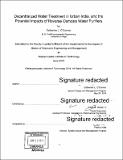Decentralized water treatment in urban India, and the potential impacts of reverse osmosis water purifiers
Author(s)
O'Connor, Catherine L. (Catherine Leber)
DownloadFull printable version (39.98Mb)
Other Contributors
Massachusetts Institute of Technology. Engineering Systems Division.
Advisor
Amos G. Winter, V.
Terms of use
Metadata
Show full item recordAbstract
The degrading water quality in India combined with reduced groundwater supplies and insufficient municipal water distribution has led to the adoption of household water purifiers across the country. These water purifiers are used to treat water for potable consumption (drinking and cooking), and include a range of technologies capable of treating contaminants found in municipal water, groundwater, or other supplemental sources. The purifiers vary in cost, and have varying levels of accessibility to different socio-economic groups. As of 2010, market studies estimated that water purifiers, and more specifically reverse osmosis (RO) units, had not yet achieved a high level of diffusion across India, though sales were projected to greatly increase. More recent studies found levels of adoption for RO purifiers in certain urban areas growing above 50%, much higher than the 10% or less of households relying primarily on groundwater. Interviews conducted in January 2016 confirmed that households with a municipal supply were treating their water with RO purifiers, so RO adoption has spread beyond homes with only groundwater as a source. Though increased RO system diffusion may increase access to improved water quality, the purifiers require a reject line that discards 30 to 80% of the input water. The waste generated can be substantial, and for an average RO recovery of 20% treating 5.0 liters per capita per day drinking water, total up to 100 liters per household per day, 82.2 megaliters per day (MLD) within the city of Delhi, or even 2,340 MLD across all major urban areas of India if complete adoption occurs within the top two socio-economic groups. These volumes can amount to a measurable fraction of the volume of groundwater that a city extracts to supplement its surface water supply, and the volume of wastewater that goes untreated due to insufficient infrastructure. Policy and technology-based alternatives such as a water efficiency ranking program and the replacement of RO with electrodialysis, a more efficient desalination technology, align with government initiatives calling for higher efficiency and public participation, though a combined program is likely needed to make household water treatment sustainable in the long-term.
Description
Thesis: S.M. in Engineering and Management, Massachusetts Institute of Technology, School of Engineering, System Design and Management Program, Engineering and Management Program, 2016. Cataloged from PDF version of thesis. Includes bibliographical references (pages 185-191).
Date issued
2016Department
Massachusetts Institute of Technology. Engineering and Management Program; System Design and Management Program.Publisher
Massachusetts Institute of Technology
Keywords
Engineering and Management Program., System Design and Management Program., Engineering Systems Division.